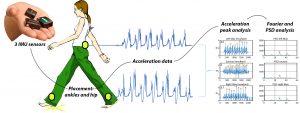ShoQR – Building a Mathematical Model to Estimate Joint Loading and Predict Joint Tissue Damage #SWI2020
We train physiotherapists in treating patients with knee osteoarthritis (degenerated, damaged cartilage). Overload of joints should be avoided, especially the repetitive impact on the affected leg, as this is related to cartilage degeneration. Three-dimensional motion analysis allows us to measure joint load with high precision but is very expensive. Together with physiotherapists and universities, we recognized the need for a clinically feasible measurement instrument. Our solution is called ShoQR.
ShoQR is a measurement instrument that uses 3 inertial measurement units (IMU), attached to the ankles and hip. An IMU consists of an accelerometer, gyroscope, and magnetometer. Respectively, they measure acceleration, angular velocity, and orientation relative to Earth’s magnetic field. A custom-built algorithm calculates loading parameters such as ankle acceleration peaks that occur at each foot strike. Fourier and Power Spectrum Density analyses are used to measure vibrations resulting from each impact. Shock absorption characteristics of the leg are obtained by comparing ankle and hip outcomes.
These outcomes differ statistically between patients and healthy controls, indicating that the system is a potential diagnostic tool and may aid in optimizing treatment strategies. However, clinical interpretation is hard as the relation between these outcome measures and tissue quality is not well understood. A mathematical model could solve this:
The objective for the Study Group is therefore to design a mathematical model that…
– …describes the leg as a series of springs or spring-dampers (i.e. bone and cartilage elements) with adjustable mechanical properties;
– …uses as input a single impact to one end of the system;
– …calculates acceleration peaks and/or vibrations that occur at the other end of the system (the hip).
If the model is able to predict the outcome well, we could use data from ShoQR as input and output to then estimate the mechanical properties of the elements in the system. This would be of immense value to a clinician and has to our knowledge not been attempted before.


